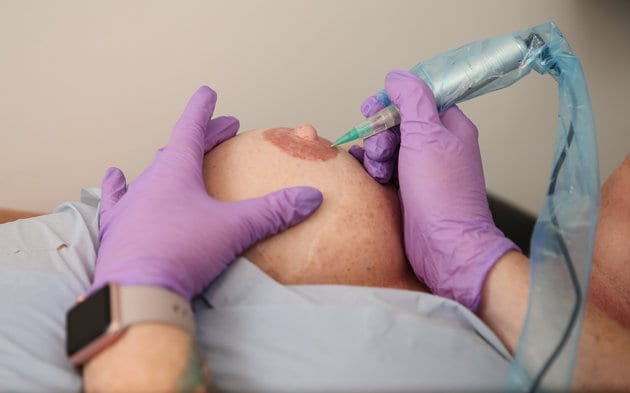Contents
Areola
Areola anatomy
Areola position. The mammary gland is a paired exocrine gland located on the anterior and upper surfaces of the thorax. In humans, it forms an undeveloped whitish mass. In women, it is also undeveloped at birth.
Breast formation. From puberty in women, the different parts of the mammary gland, including the milk ducts, lobes and peripheral subcutaneous tissue, develop to form the breast1. The surface of the mammary gland is covered with subcutaneous cell tissue and skin. On the surface and in its center, a brownish cylindrical protrusion forms and constitutes the nipple. This nipple is made up of pores which are the milk ducts coming from the different lobes of the mammary gland. This nipple is also surrounded by a brownish pigmented skin disc, with a diameter varying from 1,5 to 4 cm and constituting the areola (1) (2).
Areola structure. The areola presents about ten small projections called tubercles of Morgagni. These tubers constitute sebaceous glands. During pregnancy and lactation, these glands become more numerous and bulky. They are called Montgoméry tubers (2).
Interaction. The areola and the nipple, constituting the areola-nipple plate, are in contact with the mammary gland. They are connected to the gland by Cooper’s ligaments (1) (2). Only a circular smooth muscle is positioned between the skin of the areolo-nipple plate and the gland, called the areolo-nipple muscle. (1) (2)
The case of thelotism
Thelotism refers to the retraction and forward projection of the nipple caused by the contraction of the areolo-nipple muscle. These contractions may be due to excitement, a reaction to cold, or sometimes to simple contact of the areolar-nipple plate.
Areola pathologies
Benign breast disorders. The breast may have benign conditions or benign tumors. Cysts are the most common benign conditions. They correspond to the formation of a pocket filled with fluid in the breast.
Breast cancer. Malignant tumors can develop in the breast, and in particular in the areolo-nipple region. There are different types of breast cancer which are categorized based on their cellular origin. Affecting the areolo-nipple region, Paget’s disease of the nipple is a rare form of breast cancer. It develops within the milk ducts and may spread out to the surface, causing a scab to form on the areola and nipple.
Areola treatments
Medical treatment. Depending on the pathology diagnosed and the course of the disease, certain drug treatments may be prescribed. They are often prescribed in addition to another form of treatment.
Chemotherapy, radiotherapy, hormone therapy, targeted therapy. Depending on the stage and type of tumor, sessions of chemotherapy, radiotherapy, hormone therapy or even targeted therapy can be performed.
Surgical treatment. Depending on the type of tumor diagnosed and the progress of the pathology, a surgical intervention may be implemented. In conservative surgery, a lumpectomy can be done to remove only the tumor and some peripheral tissue. In more advanced tumors, a mastectomy may be performed to remove the entire breast.
Breast prosthesis. Following the deformation or loss of one or both breasts, an internal or external breast prosthesis may be placed.
- Internal breast prosthesis. This prosthesis corresponds to breast reconstruction. It is performed by surgery either during lumpectomy or mastectomy, or during a second operation.
- External breast prosthesis. Different external breast prostheses exist and do not require any surgical operation. They can be temporary, partial or permanent.
Areola exams
Physical examination. First, a clinical examination is performed in order to observe and assess the symptoms perceived by the patient.
Medical imaging exams Unemammography, breast ultrasound, MRI, scintimammography, or even galactography can be performed to diagnose or confirm a pathology.
Biopsy. Consisting of a tissue sample, a breast biopsy can be performed.
History and symbolism of the areola
Arturo Marcacci is a 19th and 20th century Italian physiologist who gave his name to the areolo-nipple muscle, also called Marcacci muscle (4).










